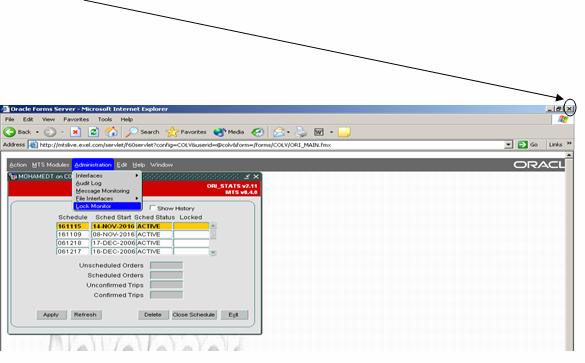Lock Monitor: Difference between revisions
m (Minor correction) |
(Merged from training document) |
||
| Line 1: | Line 1: | ||
Lock Monitor functionality in C-TMS allows users with appropriate authority to view and monitor user sessions that are locking a particular transaction. It is possible to close sessions that have been locked. | |||
One simple example where the system could lock a transaction is that when in midst of changing the details of a Order/Trip the users closes the session with C-TMS by using the ‘x’ button of the windows explorer and not properly ‘Exiting’ the C-TMS system. | |||
[[Image:lock_1.png]] | |||
Lock Monitor form can be accessed from the Administration Menu. | |||
There are multiple tabs. | There are multiple tabs. | ||
== Locks == | == Locks == | ||
The data shown in this tab will show any user that is currently within a form making changes. When they save their changes the lock will release. This is to stop other people making changes to the same record | |||
Lock Monitor allows users with appropriate authority to view and monitor user sessions that are locking a particular transaction. It is possible to close sessions that have been locked. | Lock Monitor allows users with appropriate authority to view and monitor user sessions that are locking a particular transaction. It is possible to close sessions that have been locked. | ||
By using the '''Kill Session''' button, you will be able to close the session of a particular user. All unsaved information will be lost and the user will show an error message and will have to log into C-TMS again. | |||
As this is powerful functionality, the access to this form will be restricted to a select few users. | |||
<center>[[Image:lock_locks.png|800px]]</center> | <center>[[Image:lock_locks.png|800px]]</center> | ||
| Line 13: | Line 25: | ||
== Blocks == | == Blocks == | ||
Blocking | Blocking happens when one connection from an application holds a lock and a second connection requires a conflicting lock type. This forces the second connection to wait, blocked on the first. One connection can block another connection, regardless of whether they emanate from the same application or separate applications on different client computers. | ||
When data is seen within this tab the user can kill the session(s) by clicking on the '''Kill Session''' button from within the Locks Tab. | |||
<center>[[Image:lock_blocks.png|800px]]</center> | <center>[[Image:lock_blocks.png|800px]]</center> | ||
| Line 19: | Line 33: | ||
== Sessions == | == Sessions == | ||
This tab shows all sessions that a User currently has open. Note that C-TMS is a Modal database, which means the user can open up multiple forms at the same time. Each time the user opens up a form on top of another one another session will be created. | |||
Please note that you will also see sessions in here if a developer or Administrator is accessing the system via the SQL server. | |||
<center>[[Image:lock_sessions.png|800px]]</center> | <center>[[Image:lock_sessions.png|800px]]</center> | ||
| Line 31: | Line 47: | ||
== Jobs Running == | == Jobs Running == | ||
This tab | This tab shows all running jobs in the system. | ||
<center>[[Image:lock_jobs.png|800px]]</center> | <center>[[Image:lock_jobs.png|800px]]</center> | ||
Revision as of 13:38, 9 May 2024
Lock Monitor functionality in C-TMS allows users with appropriate authority to view and monitor user sessions that are locking a particular transaction. It is possible to close sessions that have been locked.
One simple example where the system could lock a transaction is that when in midst of changing the details of a Order/Trip the users closes the session with C-TMS by using the ‘x’ button of the windows explorer and not properly ‘Exiting’ the C-TMS system.
Lock Monitor form can be accessed from the Administration Menu.
There are multiple tabs.
Locks
The data shown in this tab will show any user that is currently within a form making changes. When they save their changes the lock will release. This is to stop other people making changes to the same record
Lock Monitor allows users with appropriate authority to view and monitor user sessions that are locking a particular transaction. It is possible to close sessions that have been locked.
By using the Kill Session button, you will be able to close the session of a particular user. All unsaved information will be lost and the user will show an error message and will have to log into C-TMS again.
As this is powerful functionality, the access to this form will be restricted to a select few users.

To test this on a test system Edit a Trip in the Trip Manipulation screen then Open Lock Monitor, you will see that you have particular tables locked relating to the trip you are editing. Now open two C-TMS sessions with different user ID's and use both to access the same trip in Trip Manipulation. One user will be informed that the other user has the trip locked. (Do not try this in a production environment! Make sure you are logged into a test system first.)
Blocks
Blocking happens when one connection from an application holds a lock and a second connection requires a conflicting lock type. This forces the second connection to wait, blocked on the first. One connection can block another connection, regardless of whether they emanate from the same application or separate applications on different client computers.
When data is seen within this tab the user can kill the session(s) by clicking on the Kill Session button from within the Locks Tab.
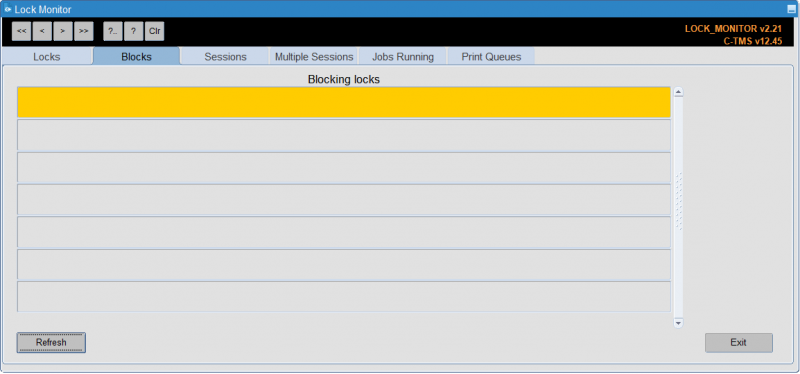
Sessions
This tab shows all sessions that a User currently has open. Note that C-TMS is a Modal database, which means the user can open up multiple forms at the same time. Each time the user opens up a form on top of another one another session will be created.
Please note that you will also see sessions in here if a developer or Administrator is accessing the system via the SQL server.
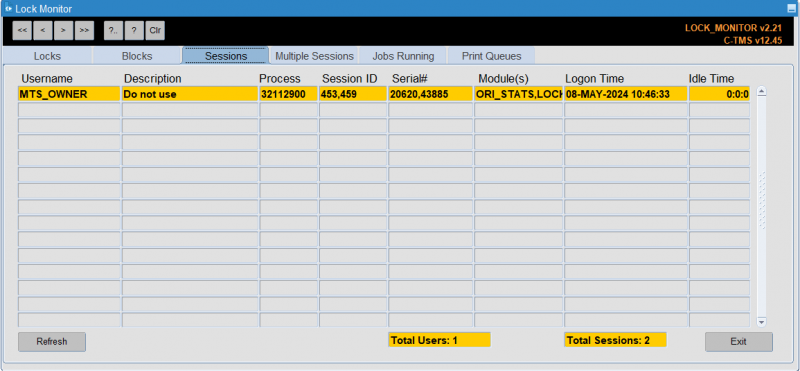
Multiple Sessions
This tab shows all users with multiple sessions open.
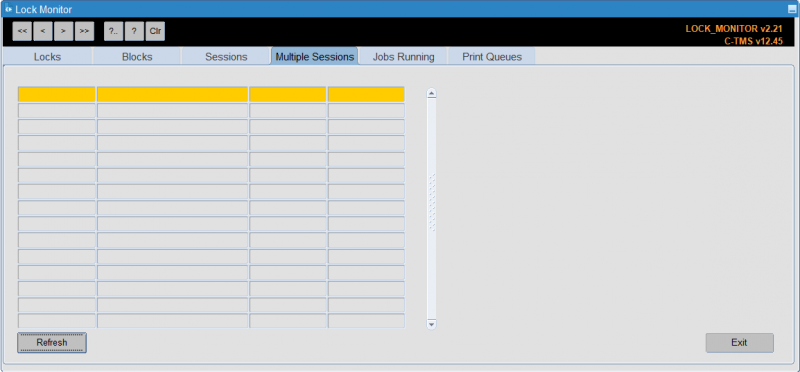
Jobs Running
This tab shows all running jobs in the system.
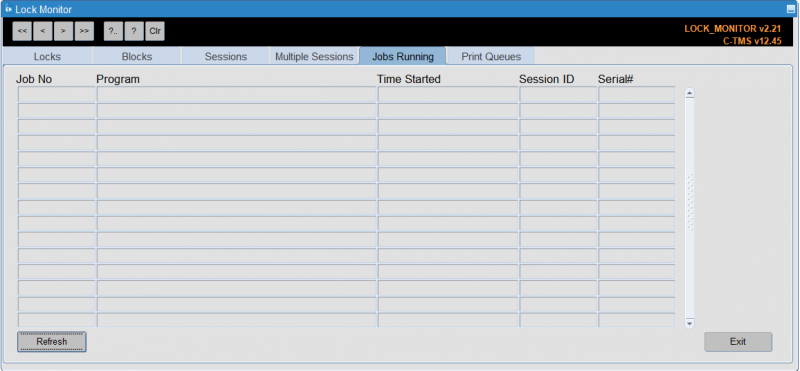
Print Queues
This tab shows all print queues.

You can find print queues through the Print Queue field - a lookup is provided. You can bring up details of the print queue with the Refresh button.
You can restart the queue, cancel the running job or cancel all jobs with the provided buttons.
